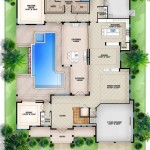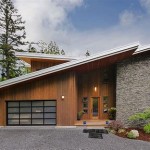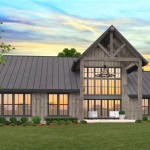House plans designed for a view are architectural blueprints specifically created to maximize the visual appeal of a home’s surroundings. These plans prioritize the orientation of the home, the placement of windows and doors, and the flow of interior spaces to provide optimal sightlines towards desirable vistas. For instance, a house plan designed for a view of the ocean may feature floor-to-ceiling windows in the living room and master bedroom, aligning with the coastline to capture panoramic views.
Designing a home with a view extends beyond maximizing scenery; it also enhances the overall living experience. Natural light flooding through large windows creates a sense of spaciousness and tranquility, while the connection to the outdoors promotes a sense of well-being. By carefully considering the surrounding landscape, architects can create homes that seamlessly blend with their environment, fostering a harmonic relationship between architecture and nature.
In the following sections, we will explore the key principles of house plans designed for a view, discussing how architects navigate challenges such as site constraints, privacy concerns, and the integration of indoor and outdoor spaces. We will also present inspiring examples of such homes, showcasing the transformative power of design in capturing the beauty of the surrounding environment and enhancing the joy of living.
8 Key Points About House Plans Designed for a View:
- Orientation: Positioned to maximize views
- Window Placement: Floor-to-ceiling windows for panoramas
- Indoor-Outdoor Flow: Seamless transitions to outdoor spaces
- Privacy Considerations: Balancing views with seclusion
- Natural Light: Large windows for ample sunlight
- Site Constraints: Navigating challenges like slopes and vegetation
- Architectural Style: Integration with surroundings
- Landscaping: Enhancing views and privacy
By considering these key points, architects can create stunning homes that not only capture breathtaking views but also provide a harmonious and enriching living environment.
Orientation: Positioned to maximize views
When designing a house plan for a view, orientation is paramount. The home’s position on the lot should be carefully considered to ensure that the most desirable vistas are captured from key living areas. This involves analyzing the surrounding landscape, including natural features like mountains, water bodies, and vegetation, as well as man-made structures and potential obstructions.
For instance, in a coastal setting, the home may be oriented towards the ocean to take advantage of panoramic views. In a mountainous region, the home may be positioned to face a specific mountain range or valley. By carefully aligning the home with its surroundings, architects can create living spaces that offer breathtaking vistas and a strong connection to nature.
Orientation also plays a crucial role in maximizing natural light and minimizing energy consumption. By positioning the home to face south in the Northern Hemisphere (or north in the Southern Hemisphere), architects can take advantage of passive solar heating, reducing the need for artificial lighting and heating systems. Additionally, strategically placed windows and skylights can capture natural light throughout the day, creating a bright and inviting interior.
Overall, careful consideration of orientation is essential for creating a house plan that maximizes views, optimizes natural light, and fosters a harmonious relationship between the home and its surroundings.
Window Placement: Floor-to-ceiling windows for panoramas
In house plans designed for a view, window placement plays a crucial role in capturing and framing the surrounding landscape. Floor-to-ceiling windows have become increasingly popular in contemporary architecture, offering unobstructed views and creating a seamless connection between indoor and outdoor spaces.
- Maximize Views: Floor-to-ceiling windows extend from the floor to the ceiling, providing expansive views of the surroundings. This allows natural light to flood the interior and creates a sense of openness and spaciousness. By eliminating visual barriers, these windows transform the home into an observation deck, offering breathtaking panoramas at every turn.
- Blurring Boundaries: Floor-to-ceiling windows blur the boundaries between indoor and outdoor spaces, creating a harmonious flow between the two. The absence of traditional window frames and sills allows for an uninterrupted connection to the exterior, enhancing the sense of immersion in nature. This seamless transition invites the outdoors in, making the landscape an integral part of the living experience.
- Natural Light Optimization: Floor-to-ceiling windows allow for maximum natural light penetration, creating a bright and airy interior. By capturing sunlight throughout the day, these windows reduce the need for artificial lighting, contributing to energy efficiency. The abundant natural light not only enhances the ambiance of the home but also promotes well-being by providing occupants with vitamin D and connecting them to the natural rhythms of the day.
- Architectural Statement: Floor-to-ceiling windows make a bold architectural statement, adding a touch of grandeur and sophistication to any home. Their sleek lines and minimalist design complement modern and contemporary architectural styles, creating a striking visual impact. These windows can also be combined with other design elements, such as balconies or terraces, to further enhance the connection to the outdoors.
Overall, floor-to-ceiling windows are an essential element in house plans designed for a view. They maximize views, blur the boundaries between indoor and outdoor spaces, optimize natural light, and make a striking architectural statement. By carefully considering window placement, architects can create homes that not only capture breathtaking vistas but also provide a seamless and harmonious living experience.
Indoor-Outdoor Flow: Seamless transitions to outdoor spaces
In house plans designed for a view, seamless transitions between indoor and outdoor spaces are essential for creating a harmonious and immersive living experience. By blurring the boundaries between the interior and exterior, architects can extend the living space beyond the walls of the home, allowing occupants to fully embrace the beauty of their surroundings.
- Decks and Patios: Decks and patios are classic examples of seamless indoor-outdoor flow. These outdoor living areas provide a direct connection to the landscape, offering a place to relax, dine, or simply enjoy the views. Decks and patios can be designed to complement the architectural style of the home, creating a cohesive and visually appealing transition between indoor and outdoor spaces.
- Sliding Doors and Bi-fold Doors: Sliding doors and bi-fold doors are popular choices for creating wide openings between indoor and outdoor areas. These doors can be fully retracted, removing the physical barrier between the interior and exterior and creating a sense of continuity. By opening up the home to the outdoors, these doors allow for effortless transitions and maximize the enjoyment of the surrounding views.
- Indoor-Outdoor Rooms: Indoor-outdoor rooms are designed to seamlessly blend the interior and exterior, creating hybrid spaces that can be used for a variety of purposes. These rooms typically feature large windows or retractable walls that open up to an adjacent outdoor area, allowing for natural ventilation and a connection to nature. Indoor-outdoor rooms provide the flexibility to enjoy the outdoors without compromising the comforts of the indoors, making them ideal for year-round use.
- Landscaping as a Transition: Landscaping can play a crucial role in creating a seamless transition between indoor and outdoor spaces. By carefully positioning plants, trees, and other landscaping elements, architects can extend the visual appeal of the home into the surrounding landscape, creating a harmonious flow between the built and natural environments. Landscaping can also provide privacy and shade, making outdoor areas more comfortable and inviting.
Overall, seamless indoor-outdoor flow is a key aspect of house plans designed for a view. By creating spaces that effortlessly transition between the interior and exterior, architects can enhance the living experience, maximize the enjoyment of the surrounding views, and foster a deeper connection to nature.
Privacy Considerations: Balancing views with seclusion
In house plans designed for a view, striking a balance between maximizing views and maintaining privacy is crucial. While expansive windows and open floor plans offer breathtaking vistas, they can also compromise the sense of privacy and security. Architects must carefully consider design strategies that allow occupants to enjoy the views without sacrificing their seclusion.
- Strategic Window Placement: Window placement is a key factor in ensuring privacy. Architects can position windows to capture views while minimizing exposure to neighboring properties or public areas. This may involve placing windows higher up on walls, using frosted or tinted glass, or incorporating window treatments such as curtains or blinds. By carefully controlling the amount and direction of natural light entering the home, architects can create a sense of privacy while still maintaining a connection to the outdoors.
- Landscaping for Privacy: Landscaping can play a significant role in enhancing privacy. Planting trees, shrubs, or hedges around the perimeter of the home can create a natural barrier that obstructs views from outside while maintaining the connection to nature. Strategically placed trees can also provide shade and reduce heat gain, making outdoor areas more comfortable and inviting.
- Fencing and Walls: In some cases, fencing or walls may be necessary to ensure privacy. These barriers can be designed to complement the architectural style of the home and blend seamlessly into the surrounding landscape. By carefully considering the height, material, and design of fencing or walls, architects can create a sense of security and privacy without sacrificing the enjoyment of the views.
- Separate Outdoor Spaces: Creating separate outdoor spaces can also enhance privacy. By designating specific areas for private relaxation, dining, or entertainment, architects can minimize the potential for overlooking from neighboring properties. These spaces can be enclosed by landscaping, fencing, or walls, providing a secluded sanctuary for the occupants to enjoy the outdoors without compromising their privacy.
Overall, balancing views with privacy in house plans designed for a view requires careful consideration of window placement, landscaping, fencing, and the creation of separate outdoor spaces. By thoughtfully integrating these strategies, architects can create homes that offer the best of both worlds: breathtaking vistas and a sense of seclusion and privacy.
Natural Light: Large windows for ample sunlight
In house plans designed for a view, large windows play a pivotal role in capturing and distributing natural light, creating a bright and inviting interior. By maximizing the use of windows, architects can reduce the reliance on artificial lighting, promote well-being, and enhance the overall ambiance of the home.
Large windows allow for ample sunlight to penetrate the interior spaces, reducing the need for artificial lighting during the day. This not only contributes to energy efficiency but also promotes a healthier living environment. Natural light has been shown to boost mood, improve sleep quality, and reduce stress levels. By incorporating large windows into the design, architects can create homes that are not only visually appealing but also conducive to physical and mental well-being.
Windows also play a crucial role in regulating temperature and air quality. By allowing sunlight to enter the home, windows help to warm the interior spaces, reducing the need for additional heating during cooler months. Additionally, windows provide natural ventilation, allowing fresh air to circulate throughout the home and improving indoor air quality. This can be especially beneficial in areas with high levels of pollution or humidity.
Moreover, large windows can visually expand the interior spaces, creating a sense of spaciousness and grandeur. By blurring the boundaries between the interior and exterior, windows bring the outdoors in, making the surrounding landscape an integral part of the living experience. This connection to nature can reduce feelings of confinement and promote a sense of tranquility.
Site Constraints: Navigating challenges like slopes and vegetation
Slopes
Sloping sites present unique challenges for house plans designed for a view. Architects must carefully consider the orientation of the home on the slope to maximize views while minimizing the impact on the surrounding landscape. This may involve creating split-level designs, incorporating retaining walls, or using stilts to elevate the home above the slope. By thoughtfully addressing the challenges of sloping sites, architects can create homes that seamlessly blend into the natural topography while capturing breathtaking vistas.
Vegetation
Existing vegetation on a site can both enhance and obstruct views. Architects must carefully assess the vegetation and determine which trees or plants to preserve and which to remove. Preserving mature trees can provide shade, privacy, and a sense of connection to nature. However, strategically removing vegetation can open up views and create a more dramatic visual impact. By carefully considering the interplay between vegetation and views, architects can create homes that harmonize with the surrounding landscape while maximizing the enjoyment of the vistas.
Combining Natural Elements
In addition to addressing individual site constraints, architects must also consider how to combine natural elements to create a cohesive and visually appealing design. For example, a home on a sloping site may incorporate a terrace or balcony that takes advantage of the elevated views. By seamlessly integrating natural elements into the design, architects can create homes that not only capture breathtaking vistas but also embrace the unique characteristics of the site.
Overall, navigating site constraints in house plans designed for a view requires a thoughtful and creative approach. By carefully considering the challenges and opportunities presented by the site, architects can create homes that not only maximize views but also harmonize with the surrounding landscape. Embracing the unique characteristics of each site allows architects to design homes that are both visually stunning and deeply connected to their natural environment.
Architectural Style: Integration with surroundings
The architectural style of a house plan designed for a view plays a crucial role in integrating the home with its surroundings. The style should complement the natural landscape and enhance the enjoyment of the vistas. By carefully considering the materials, forms, and details of the home’s design, architects can create a harmonious relationship between the built environment and the natural world.
Organic Architecture: Organic architecture, pioneered by architects like Frank Lloyd Wright, emphasizes the integration of buildings into their natural surroundings. Organic homes often feature natural materials, such as wood and stone, and flowing forms that mimic the curves and textures found in nature. By blending seamlessly with the landscape, organic homes create a sense of unity and tranquility.
Contemporary Architecture: Contemporary architecture is characterized by its clean lines, geometric forms, and use of glass and steel. Contemporary homes often feature floor-to-ceiling windows that maximize views and bring the outdoors in. The simplicity of contemporary design allows the surrounding landscape to take center stage, creating a harmonious relationship between the home and its environment.
Vernacular Architecture: Vernacular architecture refers to the traditional building styles of a particular region or culture. Vernacular homes are often designed to respond to the local climate and landscape. By incorporating elements of vernacular architecture into a house plan designed for a view, architects can create a home that is both visually appealing and deeply connected to its surroundings.
Overall, the architectural style of a house plan designed for a view should be carefully considered to ensure that the home integrates seamlessly with its surroundings. By selecting materials, forms, and details that complement the natural landscape, architects can create homes that not only capture breathtaking vistas but also foster a harmonious relationship between the built environment and the natural world.
Landscaping: Enhancing views and privacy
Landscaping plays a multifaceted role in enhancing the visual appeal and privacy of house plans designed for a view. By carefully selecting and arranging plants, trees, and other landscaping elements, architects can create outdoor spaces that complement the home’s architecture, frame the surrounding landscape, and provide a sense of seclusion.
Framing Views: Landscaping can be used to frame and enhance specific views from the home. By planting trees or shrubs in strategic locations, architects can create a visual corridor that draws the eye towards a particular focal point, such as a mountain range, a body of water, or a cityscape. This technique can help to maximize the impact of the views and create a sense of connection to the surrounding environment.
Creating Privacy: Landscaping can also be used to create privacy and reduce the visibility of the home from neighboring properties or public areas. Planting dense hedges or rows of trees around the perimeter of the property can act as a natural barrier, blocking unwanted views and providing a sense of seclusion. Additionally, strategically placed trees or shrubs can be used to screen specific areas of the home, such as patios or balconies, from prying eyes.
Enhancing Outdoor Spaces: Landscaping can transform outdoor spaces into inviting and functional areas that complement the views and provide a seamless transition between the interior and exterior of the home. By incorporating patios, decks, or pergolas into the landscaping, architects can create comfortable and sheltered spaces for outdoor dining, relaxation, or entertainment. These outdoor areas can be further enhanced with outdoor furniture, lighting, and water features, creating a cohesive and visually appealing living environment.
Overall, landscaping is an essential element in house plans designed for a view. By carefully considering the selection and placement of plants, trees, and other landscaping elements, architects can create outdoor spaces that not only enhance the views but also provide privacy and a seamless transition between the interior and exterior of the home.










Related Posts








